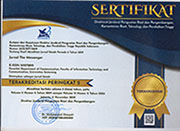Common Language of New Era in Sport Clubs: Emojis
Abstract
Keywords
Full Text:
PDFReferences
Abeza, G., O Reilly, N., Seguin, B., & Nzindukiyimana, O. (2017). Social media as a relationship marketing tool in professional sport: A netnographical exploration. International Journal of Sport Communication, 10(3), 325 358. https://doi.org/https://doi.org/10.1123/ijsc.2017-0041
Alshenqeeti, H. (2016). Are emojis creating a new or old visual language for new generations? A socio-semiotic study. Advances in Language and Literary Studies, 7(6), 56 69. https://doi.org/https://doi.org/10.7575/aiac.alls.v.7n.6p.56
Barbieri, F., Ronzano, F., & Saggion, H. (2016). What does this emoji mean? A vector space skip-gram model for twitter emojis. In. In N. Calzolari, K. Choukri, T. Declerck, S. Goggi, M. Grobelnik, B. Maegaard, J. Mariani, H. Mazo, A. Moreno, J. Odijk, & S. Piperidis. (Eds.), Proceedings of the Tenth International Conference on Language Resources and Evaluation (LREC 2016) (pp. 3967 3972). European Language Resources Association. http://www.lrec-conf.org/proceedings/lrec2016/summaries/735.html
Bauer, H., Barnes, S. J., Reichardt, T., & Neumann, M. . (2005). Driving consumer acceptance of mobile marketing: A theoretical framework and empirical study. Journal of Electronic Commerce Research, 6(3), 181-192. http://directory.umm.ac.id/articles/Baueretal_MomMarketingConsumerAccept.pdf
Berard, B. (2018). I second that emoji: The standards, structures, and social production of emoji. First Monday, 23(9). https://doi.org/https://doi.org/10.5210/fm.v23i9.9381
Blagdon, J. (2013). How emoji conquered the World. Theverge. https://www.theverge.com/2013/3/4/3966140/how-emoji-conquered-the-world
Blaszka, M. (2011). An xamination of sport consumers Twitter usage [Unpublished master of science dissertation] [Georgia State University]. https://scholarworks.gsu.edu/kin_health_theses/1
Bosch Jover, O., & Revilla, M. A. (2018). The Use of Emojis by Millennials (No. 57; RECSM Working Paper). https://www.upf.edu/documents/3966940/6839730/Working+Paper_Emoji_Substantive.pdf/bbbf386b-864f-3116-b8fb-dece14760a45
Boulianne, S. (2015). Social media use and participation: A meta-analysis of current research. Information, Communication & Society, 18(5), 524 538. https://doi.org/https://doi.org/10.1080/1369118X.2015.1008542
Cincu, R. (2017). Emoticons: between Linguistic innovation and Symptom of the Posthuman Era. Journal of Media Research-Revista de Studii Media, 10(27), 88-95.
Cowie, R., Douglas-Cowie, E., Tsapatsoulis, N., Votsis, G., Kollias, S., Fellenz, W., & Taylor, J. G. (2001). Emotion recognition in human-computer interaction. IEEE Signal Processing Magazine, 18, 32 80. https://doi.org/10.1109/79.911197.
Danesi, M. (2017). The semiotics of emoji: The rise of visual language in the age of the internet. Media and Communication, 5(4), 75. https://doi.org/10.17645/mac.v5i4.1041
Das, G., Wiener, H. J., & Kareklas, I. (2019). To emoji or not to emoji? Examining the influence of emoji on consumer reactions to advertising. Journal of Business Research, 96, 147-156. https://doi.org/https://doi.org/10.1016/j.jbusres.2018.11.007
Derbaix, C., & Decrop, A. (2011). Colours and scarves: an ethnographic account of football fans and their paraphernalia. Leisure Studies, 30(3), 271 291. https://doi.org/https://doi.org/10.1080/02614367.2010.527356
Dima, T. (2015). Social media usage in European clubs football industry. Is digital reach better correlated with sports or financial performance? The Romanian Economic Journal, 18(55), 117 128. https://ideas.repec.org/a/rej/journl/v18y2015i55p117-128.html
Dimson, T. (2015). Emojineering Part 1: Machine Learning for Emoji Trends. Instagram Engineering. https://instagram-engineering.com/emojineering-part-1-machine-learning-for-emoji-trendsmachine-learning-for-emoji-trends-7f5f9cb979ad
Drapier, E. P., & Tezonarici, S. D. (2019). Analysis of Twitter behaviors of Portuguese and Turkish clubs [Molde University College]. https://himolde.brage.unit.no/himolde-xmlui/bitstream/handle/11250/2620824/master_perdigao_drapieri.pdf?sequence=1&isAllowed=y
Dresner, E., & Herring, S. C. (2010). Functions of the nonverbal in CMC: Emoticons and illocutionary force. Communication Theory, 20(3), 249-268. https://doi.org/https://doi.org/10.1111/j.1468-2885.2010.01362.x
Dua, T. (2015). The emojification of brand advertising. Digiday. https://digiday.com/marketing/emojification-brand-advertising/
Emogi Research Team. (2016). Emoji Report. https://cdn.emogi.com/docs/reports/2016_emoji_report.pdf
Fahlman, S. E. (2002). Smiley Lore :-). Carnegie Mellon University. https://www.cs.cmu.edu/~sef/sefSmiley.htm
Figge, S. (2004). Situation-dependent services-a challenge for mobile network operators. Journal of Business Research, 57(12), 1416 1422. https://doi.org/https://doi.org/10.1016/S0148-2963(02)00431-9
Filo, K., Lock, D., & Karg, A. (2015). Sport and social media research: A review. Sport Management Review, 18(2), 166 181. https://doi.org/https://doi.org/10.1016/j.smr.2014.11.001
Fraenkel, J. R., Wallen, N. E., & Hyun, H. H. (2012). How to Design and Evaluate Research in Education (8th ed.). McGraw-Hill Companies, Inc.
Ganster, T., Eimler, S. C., & Kraemer, N. C. (2012). Same same but different!? The differential influence of smiles and emoticons on person perception. Cyberpsychology, Behavior, and Social Networking, 15(4), 226 230. https://doi.org/10.1089/cyber.2011.0179.
Garris, M., & Mishra, K. (2014). A beginner s guide to mobile marketing. Business Expert Press.
Giannoulis, E., & Wilde, L. R. A. (2019). Emoticons, kaomoji, and emoji: The transformation of communication in the digital age (1st ed.). Routledge.
Gibbs, C., & Haynes, R. (2013). A phenomenological investigation into how Twitter has changed the nature of sport media relations. International Journal of Sport Communication, 7(2), 188 213. https://doi.org/https://doi.org/10.1123/IJSC.2014-0005
Gibbs, C., O Reilly, N., & Brunette, M. (2014). Professional Team Sport and Twitter: Gratifications Sought and Obtained by Followers. International Journal of Sport Communication, 7(2), 188 213. https://doi.org/https://doi.org/10.1123/IJSC.2014-0005
Grewal, D., & Levy, M. (2019). Marketing. (6th ed.). McGraw-Hill.
Gr ¶nroos, C. (2004). The relationship marketing process: Communication, interaction, dialogue, value. Journal of Business & Industrial Marketing, 19(2), 99 113. https://doi.org/https://doi.org/10.1108/08858620410523981
G ¼lÅŸen, T. T. (2016). You tell me in emojis. In T. Ogata & T. Akimoto (Eds.), Computational and Cognitive approaches to Narratology (pp. 354-375). IGI Global. https://doi.org/10.4018/978-1-5225-0432-0.ch014
Hambrick, M. E. (2012). Six degrees of information: Using social network analysis to explore the spread of information within sport social networks. International Journal of Sport Communication, 5(1), 16 34. https://doi.org/https://doi.org/10.1123/ijsc.5.1.16
Highfield, T. (2018). Emoji hashtags//hashtag emoji: of platforms, visual affect, and discursive flexibility. First Monday, 23(9). https://doi.org/https://doi.org/10.5210/fm.v23i9.9398
Hill, J. H. (2016). The impact of emojis and emoticons on online consumer reviews, perceived company response quality, brand relationship, and purchase intent [Unpublished master of arts dissertation [University of South Florida]. https://digitalcommons.usf.edu/etd/6513
Hopkins, J. L. (2013). Engaging Australian rules football fans with social media: A case study. International Journal of Sport Management and Marketing, 13(1/2), 104 121. https://doi.org/10.1504/IJSMM.2013.055197
Hougaard, T. T., & Rathje, M. (2018). Emojis in the digital writings of young Danes. In A. Ziegler (Ed.), Jugendsprachen/Youth languages: Aktuelle perspektiven internationaler forschung/current perspectives of international research (pp. 773 806). De Gruyter. https://doi.org/https://doi.org/10.1515/9783110472226
Jackson, D. (2015). How to Go Viral: 8 Steps to Reach a Massive Audience. Sproutsocial. https://sproutsocial.com/insights/how-to-go-viral/
Jaeger, S. R., & Ares, G. (2017). Dominant meanings of facial emoji: Insights from Chinese consumers and comparison with meanings from internet resources. Food Quality and Preference, 62, 275 283. https://doi.org/https://doi.org/10.1016/j.foodqual.2017.04.009
Jaeger, S. R., Vidal, L., Kam, K., & Ares, G. (2018). Can emoji be used as a direct method to measure emotional associations to food names? Preliminary investigations with consumers in USA and China. Food Quality and Preference, 68, 38 48. https://doi.org/https://doi.org/10.1016/j.foodqual.2016.09.005
Kaye., K. (2015). FORD, DOMINO S, DELL, OTHERS WORK TO TRANSLATE THE LANGUAGE OF EMOJIS. Advertising Age. https://adage.com/article/digital/marketers-work-translate-language-emojis/301064
Kolpe, R., & Burnett, M. (1991). Content analysis research: An examination of applications with directives for improving research reliability and objectivity. Journal of Consumer Research, 18(2), 243 250. https://doi.org/https://doi.org/10.1086/209256
Krippendorff, K. (2004). Reliability in Content Analysis: Some Common Misconceptions and Recommendations. Human Communication Research, 30(3), 411 433. https://doi.org/https://doi.org/10.1111/j.1468-2958.2004.tb00738.x
Lefever, K. (2012). New Media and Sport. Springer. https://link.springer.com/book/10.1007/978-90-6704-873-6
Li, J., Longinos, G., Wilson, S., & Magdy, W. (2020). Emoji and Self-Identity in Twitter Bios. Proceedings of the Fourth Workshop on Natural Language Processing and Computational Social Science. https://doi.org/http://dx.doi.org/10.18653/v1/2020.nlpcss-1.22
Lin, K.-Y., & Lu, H.-P. (2011). Intention to Continue Using Facebook Fan Pages from the Perspective of Social Capital Theory. Cyberpsychology, Behavior, and Social Networking, 14(10). https://doi.org/https://doi.org/10.1089/cyber.2010.0472
Lombard, M., Snyder-Duch, J., & Bracken, C. C. (2006). Content Analysis in Mass Communication: Assessment and Reporting of Intercoder Reliability. Human Communication Research, 28(4), 587 604. https://doi.org/https://doi.org/10.1111/j.1468-2958.2002.tb00826.x
M.Nisar, T., Prabhakar, G., & P.Patil, P. (2018). Sports clubs use of social media to increase spectator interest. International Journal of Information Management, 43, 188 195. https://doi.org/https://doi.org/10.1016/j.ijinfomgt.2018.08.003
Manovich, L. (2001). The Language of New Media. The MIT Press.
Maree, T. (2017). The Social Media Use Integration Scale: Toward Reliability and Validity. International Journal of Human Computer Interaction, 33(12), 963 972. https://doi.org/https://doi.org/10.1080/10447318.2017.1301041
Marengo, D., Giannotta, F., & Settanni, M. (2017). Assessing personality using emoji: An exploratory study. Personality and Individual Differences, 112, 74 78. https://doi.org/https://doi.org/10.1016/j.paid.2017.02.037
McBain, S. (2017). Happy face, sad face are emojis the nearest thing to a universal language? More people speak emoji than English. New Statesman. https://www.newstatesman.com/science-tech/2017/09/happy-face-sad-face-are-emojis-nearest-thing-universal-language
Neuman, W. L. (2020). Social research methods: Qualitative and quantitative approaches (8th ed.). Pearson.
Nicholson, M., Kerr, A., & Sherwood, M. (2015). Sport and the Media: Managing the Nexus. (2nd ed.). Routledge. https://www.routledge.com/Sport-and-the-Media-Managing-the-Nexus/Nicholson-Kerr-Sherwood/p/book/9780415839822
Novak, P. K., Smailović, J., Sluban, B., & MozetiÄ, I. (2015). Sentiment of Emojis. PLoS One, 1 22. https://doi.org/10.1371/journal.pone.0144296
O Shea;, M., & Alonso, A. D. (2011). Opportunity or obstacle? A preliminary study of professional sport organisations in the age of social media. International Journal of Sport Management and Marketing, 10(3/4), 196 212. https://doi.org/https://dx.doi.org/10.1504/IJSMM.2011.044790
Oelrichs, I. (2020). Adoption of Innovations in Digital Sports Journalism: The Use of Twitter by German Sports Journalists. Sage Journals. https://doi.org/https://doi.org/10.1177%2F2167479520961786
Pavalanathan, U., & Eisenstein, J. (2016). More emojis, less :) The competition for paralinguistic function in microblog writing. First Monday, 21(11). https://doi.org/https://doi.org/10.5210/fm.v21i11.6879
Pegoraro, A. (2010). Look Who s Talking €”Athletes on Twitter: A Case Study. International Journal of Sport Communication, 3, 501 514. https://doi.org/https://doi.org/10.1123/ijsc.3.4.501
Pohl, H., Domin, C., & Rohs, M. (2017). Beyond Just Text: Semantic Emoji Similarity Modeling to Support Expressive Communication ??? ACM Transactions on Computer-Human Interaction, 24(1), 1 42. https://doi.org/https://doi.org/10.1145/3039685
Poster, M. (2013). The Second Media Age. Polity. https://www.wiley.com/en-us/The+Second+Media+Age-p-9780745668239
Potter, W. J., & Levine €Donnerstein, D. (2009). Rethinking Validity and Reliability in Content Analysis. Journal of Applied Communication Research, 27(3), 258 284. https://doi.org/https://doi.org/10.1080/00909889909365539
Price, J., Farrington, N., & Hall, L. (2013). Changing the game? The impact of Twitter on relationships between football clubs, supporters and the sports media. Soccer & Society, 14(4), 446 461. https://doi.org/https://doi.org/10.1080/14660970.2013.810431
Rezabek, L., & Cochenour, J. (1998). Visual Cues in Computer-Mediated Communication: Supplementing Text with Emoticons. Journal of Visual Literacy, 18(2), 201 215. https://doi.org/https://doi.org/10.1080/23796529.1998.11674539
Rodrigues, D., Prada, M., Gaspar, R., Garrido, M. V., & Lopes, D. (2018). Lisbon Emoji and Emoticon Database (LEED): Norms for emoji and emoticons in seven evaluative dimensions. Behav Res, 50(392 405). https://doi.org/https://doi.org/10.3758/s13428-017-0878-6
Selken, N. (2019). Emoji Dictionary. Moji Dictionary. https://emojidictionary.emojifoundation.com/
Siguencia, L. O., Marzano, D. H. G., & Rodak, P. (2017). The Role of Social Media in Sports Communication Management: An Analysis of Polish Top League Teams Strategy. Procedia Computer Science, 104, 73 80. https://doi.org/https://doi.org/10.1016/j.procs.2017.01.074
Stark, L., & Crawford, K. (2015). The Conservatism of Emoji: Work, Affect, and Communication. Sage Journals. https://doi.org/https://doi.org/10.1177%2F2056305115604853
Swaney-Stueve, M., Jepsen, T., & Deubler, G. (2018). The emoji scale: A facial scale for the 21st century. Food Quality and Preference, 68, 183 190. https://doi.org/https://doi.org/10.1016/j.foodqual.2018.03.002
Tian, Y., Galery, T., Dulcinati, G., Molimpakis, E., & Sun, C. (2017). Facebook sentiment: Reactions and Emojis. In L.-W. Ku & C.-T. Li (Eds.), Proceedings of the Fifth International Workshop on Natural Language Processing for Social Media. Association for Computational Linguistics. https://aclanthology.org/W17-1102
Tocci, R. J. ., Widmer, N., & Moss, G. (2007). Digital Systems: Principles and Applications (10th ed.). Pearson. https://www.pearson.com/uk/educators/higher-education-educators/program/Tocci-Digital-Systems-Principles-and-Applications-10th-Edition/PGM789304.html
Tweetfc. (2019). Tweetfc. Tweetfc. http://www.tweetsfc.com/stats/most-followed-football-teams-on-twitter
Wang, Y. (2021). Building relationships with fans: how sports organizations used twitter as a communication tool. Sport in Society, 24(7). https://doi.org/https://doi.org/10.1080/17430437.2020.1725475
Wang, Y., & Zhou, S. (2015). How Do Sports Organizations Use Social Media to Build Relationships? A Content Analysis of NBA Clubs Twitter Use. International Journal of Sport Communication, 8(2), 133 148. https://doi.org/https://doi.org/10.1123/ijsc.2014-0083
Watkins, B. A. (2013). Social media & sports: an evaluation of the influence of Twitter and mobile apps on brand-related consequences [University of Alabama]. https://ir.ua.edu/handle/123456789/1821
We are Social Inc. (2019). Digital 2019: Internet trends in 2019. Wearesocial. https://wearesocial.com/global-digital-report-2019
Weber, R. (1990). Basic Content Analysis (2nd ed.). SAGE researchmetode. https://doi.org/https://dx.doi.org/10.4135/9781412983488
Williams, J., & Chinn, S. J. (2010). Meeting Relationship-Marketing Goals Through Social Media: A Conceptual Model for Sport Marketers. International Journal of Sport Communication, 3(4), 422 437. https://doi.org/https://doi.org/10.1123/ijsc.3.4.422
Winand, M., Belot, M., Merten, S., & Kolyperas, D. (2019). International Sport Federations Social Media Communication: A Content Analysis of FIFA s Twitter Account. International Journal of Sport Communication, 12(2), 209 233. https://doi.org/https://doi.org/10.1123/ijsc.2018-0173
Yengin, D. (2015). Yeni medyanın olanakları: Semantik Web. The Turkish Online Journal of Design, Art and Communication, 5(1), 44 53. http://tojdac.org/tojdac/VOLUME5-ISSUE1_files/tojdac_v05i104.pdf
Zanini, M. T., Moraes, F. C. de, Lima, V., Migueles, C., Lourenco, C., & Irigaray, H. A. R. (2019). Soccer and Twitter: virtual brand community engagement practices. Marketing Intelligence & Planning, 37(7), 791 805. https://doi.org/https://doi.org/10.1108/MIP-08-2018-0371
Zhou, R., Hentschel, J., & Kumar, N. (2017). Goodbye Text, Hello Emoji: Mobile Communication on WeChat in China. Proceedings of the 2017 CHI Conference on Human Factors in Computing Systems, 748 759. https://doi.org/https://doi.org/10.1145/3025453.3025800
DOI: http://dx.doi.org/10.26623/themessenger.v13i1.2390
Refbacks
- There are currently no refbacks.
Copyright (c) 2021 Jurnal The Messenger
View My Stats [Jurnal The Messenger] is an International Scientific Journal, Published by the Department of Communication, Faculty of Information Technology and Communication, Universitas Semarang (Central Java, Indonesia). It is licensed under a Creative Commons Attribution 4.0 International License.



_11.jpg)




_BARCODE.jpg)
_BARCODE1.jpg)


5.png)










2.png)





